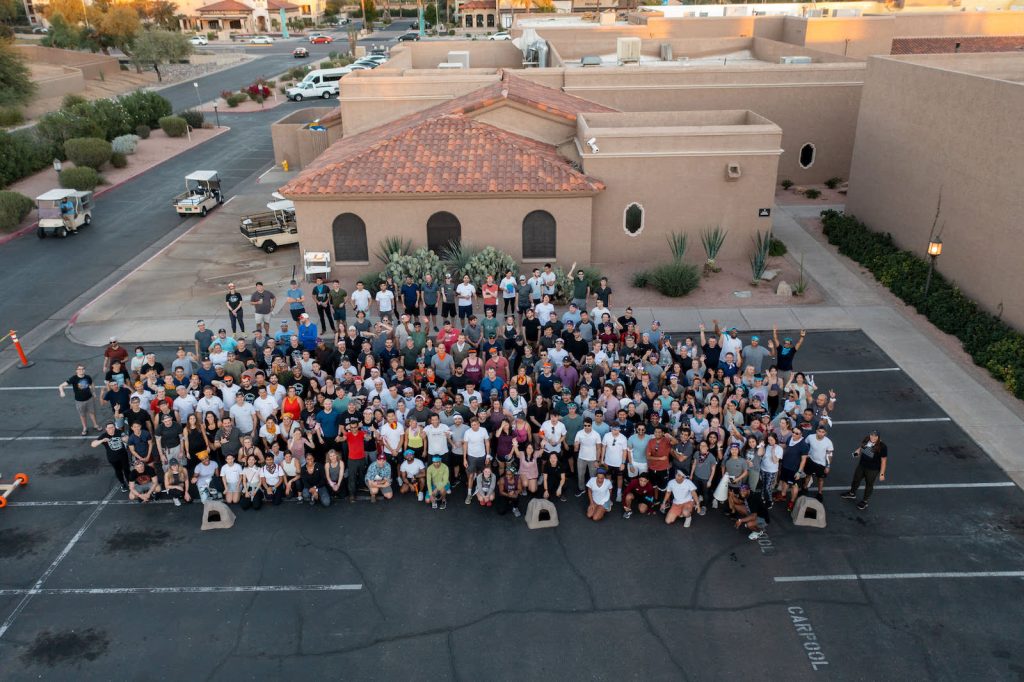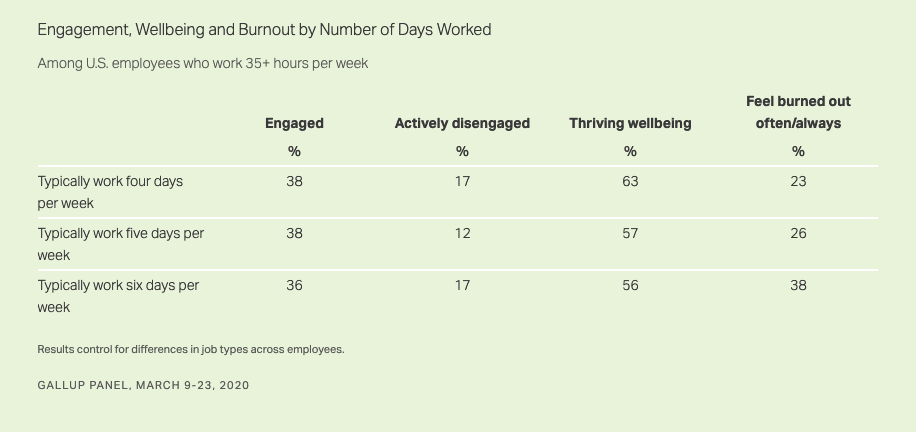If you could do your job in less time than allotted, wouldn’t you?
That’s the idea behind the 4-day workweek, a growing trend among businesses to improve employee engagement, work-life balance, and recruitment and retention.
And as a result, improve productivity, too.
The 5-day workweek, after all, is a relic from the industrial revolution when Henry Ford realised that working more hours only resulted in a small increase in productivity. And this was within the context of factory labour where there were few automations to offset pure elbow grease. These days, it should be possible to take less time to do the same amount of work.
Tech giants from Atlassian to Microsoft Japan have trialled the four day workweek. With today’s burnout culture causing employees to resign in droves, companies have good reason to drop Fridays from the weekday club.

Intuitively, it makes sense. Suprita Sinha, a behavioural analyst and coach at Intellect, explains why:
“The moment I am drained, I need to have some time off to charge my battery and get back to work. If we have four day workweeks, that’s time for recharging through self-reflection—where am I? What am I doing? How do I move ahead? It’s very important for employees to self-reflect.”
Some companies have reported increases in employee engagement and productivity like tech unicorn Bolt, which is now implementing the 4-day workweek permanently.

According to Bolt, 84% of employees said they have been more productive, 86% have been more efficient, and 84% saw an improvement in their work-life balance.
With the promise of happier employees at no compromise to productivity, there doesn’t seem to be many reasons not to try a condensed work week. Just ask the 40+ employees of a Malaysia-based company called Piktochart, whose story we’ll learn more about later in this article.
But first, a word of caution: if all that sounds too good to be true, then it probably is.
While the 4-day work week might work for some companies, it’s not the ultimate solution to all our office woes. Here’s what you should know before you bite the bullet.
4-day work weeks don’t always mean 32-hour work weeks
When you think of a 4-day work week, the best-case scenario for employees is fewer hours clocked at the same five-day salary.
So if the standard is eight hours of work a day, then that means just 32 hours of work within any given week, with no compromise to pay or productivity.
But that isn’t always the case. There are many ways to interpret or implement a 4-day work week.

Besides the reduced hours, companies might offer a compressed work week where 40 hours of work is distributed across four work days, which may result in 10-hour days, like what Japanese clothing brand Uniqlo did.
For other companies, four day work weeks are a cost-saving measure, like with Stanley Black and the Los Angeles Times. The two companies were able to trim 20% from payroll costs for three months by implementing the shorter hours.
So if your company happens to be trialling a four day workweek, make sure you know what you’re getting into before you rejoice.
Fewer days means less time to get things done
The output demands of certain companies may also not fit into a 4-day week.
Therefore, taking out a day of work means there’s less time for employees to fulfil their duties and submit deliverables, which could potentially compound their stress.
In Britain, for example, as many as two-thirds of employees are said to work 6.3 hours longer than their contracted hours per week, which implies that the standard hours of any given workweek do not necessarily match their company’s expectations for productivity. Even with longer weekends, employees might be sprinting through stressful work weeks that put them at risk of exhaustion and fatigue.

Working longer days to make up for an extra day for the weekend also isn’t the best way to go about things as employees become less productive as the day wears on.
“Our minds are like rubber bands,” Suprita explains. “If it’s pulled apart, I can stretch to an extent. But the moment I stretch it beyond a certain point, the rubber band breaks.”
People also abide by a certain circadian rhythm, so longer hours doesn’t necessarily mean more work gets done.
Mattress review company Slumber Yard, for instance, trialled ten-hour days and found that it actually harmed productivity. Since employees were coming in earlier, they treated the first hour of work as their wake-up period and spent the last two surfing the web and eating dinner since their hours covered mealtimes.
Hyper-efficiency at what cost?
One of the arguments for the shorter workweek is efficiency.
The assumption is that most of the time, employees just put on a show of working to fulfil their hours before they go. If you’re going with a reduced or 32-hour work week, employees are then able to focus on getting work done with the time they’re given.
This means less time on social media and “meetings that could have been emails.”
While this, in theory, could improve efficiency, one must ask: at what cost?
A case study for the four day workweek in New Zealand found that employees took shorter breaks and spent less time lingering for “chit chat” after tea, and spent their time trying to get work done.
This is great news for a company’s output, but it may not be great for a company’s culture. After all, something is lost when everyone is focused on hyper-efficiency. There are fewer opportunities for employees to bond and build ties, which is essential for a company’s overall success.

“Watercooler conversations are also important because they ease stress. Sometimes, these watercooler conversations turn out to be very insightful because [employees] have an exchange of ideas with another person. If I’m just having a conversation over coffee, maybe I free up my mind’s space to think more and re-energise to get back to work,” Suprita says.
It might not suit all businesses
Not every industry can afford to switch to a different working model so easily.
The ones that do will have to readapt operations, which requires a significant amount of time, effort, and consideration.
For instance, Monday to Friday businesses will need to figure out how to make sure there’s enough manpower to sustain business each day. If employees will be working in shifts, how can managers ensure that not everyone is taking the same days off?
Not to mention policies will need to be adjusted, workers will need to be briefed about the change, and it will take some time for everyone to get used to the transition.
There are also certain industries where a 4-day work week simply isn’t viable. Particularly the ones that require 24/7 support like customer service, tech support, hospitals, and fire departments.
Sometimes, it isn’t the number of workdays that’s the problem
While the 4-day work week seems to be a boon at a glance, it doesn’t necessarily solve a company’s problems.
A study by Gallup found that disengaged employees who worked five times a week became even more disengaged after the shift to four.

This means that the quality of work experience is more important than the number of days worked. Simply shortening the workweek will not magically improve employee engagement and performance if stress and burnout was already a problem before any changes were made.
Beyond the prospect of reducing hours, a significant finding from all of these trials is the importance of flexibility. Employees don’t just want to work less—though that’s not necessarily a bad thing—they want to have more control over their time. A survey of 1,000 full-time employees conducted by Visier found that 39% of employees listed “flexible hours” ahead of a “4-day work week” (24%).
After all, one of the biggest problems with the 5-day work week is that it leaves employees with little time to practice self-care or to fulfil other obligations like dropping their kids at school or doing the groceries before supermarkets close.
While the 4-day work week does give them some time back for themselves, companies need to ask themselves what other ways they can provide employees with that control and flexibility.
Piktochart CEO: figure out what works for your business
All this is not to rule out the 4-day work week as a possibility for your business. Many companies have found great success with 4-day work weeks and reaped the benefits.
Malaysia-based graphic design company Piktochart is an example of an organisation that successfully implemented the 4-day work week. At the onset of the pandemic, the company’s founder, Ai Ching Goh, noticed that employees were starting to get burned out.
“There were subtle signs. You could tell because when you were in meetings, it was as if they didn’t wake up yet. They looked really distracted. They wouldn’t complain but they would say they were working really late hours,” Ai Ching recounts.

That led Ai Ching to consider the 4-day work week—32 hours of work a week at the same pay. All employees got Fridays off, while the customer service team alternated between Fridays and Mondays to keep operations going.
After all, the company had recently become fully remote due to the pandemic, and she was confident her team had the discipline to wrap up their deliverables in a shorter amount of time.
Ai Ching’s proposition was met with a lot of skepticism. Some were concerned that it would impact productivity; if the competition was putting in five days of work, wouldn’t that put them behind? But Ai Ching went into the four day workweek with a firm understanding that this was solely for her employees:
“I got asked this question a lot and it took me some time to get some clarity as well: what are we trying to solve? At the end of the day, you don’t do a four day workweek for business outcomes. You do this for the people and the employees.”
After a transition period, Piktochart employees began to embrace the 4-day work week. And after having a taste of it, there was no going back. The company is now in its second year with it.
The ability to control your time
According to Ai Ching, employees loved the change. Some expressed having “tears of joy,” like the new moms and dads whose Fridays off mean the world to them. Others use their days off for personal development, picking up new hobbies or taking volunteering jobs on the side.
The company has also enjoyed shorter meeting hours and established an efficient cadence for getting things done.
One of the reasons the 4-day work week was a success for Piktochart was because it was founded on the principle of autonomy.
“I felt like the future of work is the ability to have control over time,” Ai Ching says. “If I just became a mom, I may potentially choose to use lesser hours. I felt that the future model of a very successful working culture would be the one that did not impose restrictions and limitations; it figures that people have to do different things.”

There were a few things about Piktochart that made it a good fit for the 4-day work week model.
First, the company had come from an in-office environment where the team had already formed very tight bonds with each other.
Second, they had members across Asia and Europe and were already practising asynchronous communication.
Finally, they were able to make hyper-efficiency work because they relied on active employee engagement rather than passive watercooler conversations.
“For some people, [the lack of watercooler conversations] might not be a problem. They still have family priorities and cannot be spending too much time engaging in social chitchat. Not all these things help build culture. It’s all about being really intentional in every single meeting. These small things matter more than watercooler conversations,” Ai Ching says.
Trust and autonomy are foundational for success
A 4-day work week is a viable option for certain companies, but it’s no antidote to an unhealthy work environment. If the goal is to create an engaging workplace culture and improve productivity, the number of hours clocked may not always be the best place to start.
Companies will need to dig deep into their workplace cultures to figure out how to solve the problem of employee engagement, keeping in mind the value of employees’ mental health and wellbeing.
“Every human being is different. It’s important to understand and communicate with people the way they want to be communicated with,” Suprita explains. “I cannot use the same medicine for everything.”
How Intellect can help
Organisations are realising that a one-size-fits-all approach doesn’t cut it when addressing employee engagement and workplace wellbeing. During Mental Health Festival 2023, CEO of the Institute of Mental Health Singapore, Associate Professor Daniel Fung, highlighted the importance of mass customisation—implementing personalised solutions on a broad scale—in this day and age.
This tailored approach entails identifying on-the-ground issues, devising practical solutions, and expanding their reach, all while incorporating real-time feedback from those involved—a methodology well acquainted to Intellect.
Explore how Intellect can set your organisation up for success here.






